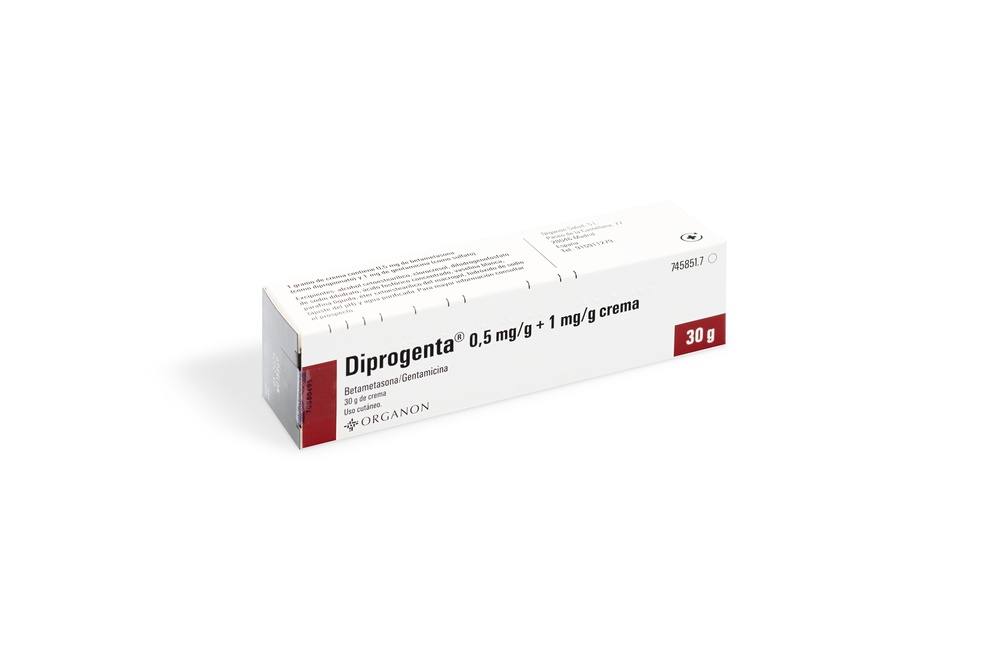

DIPROGENTA 0.5 mg/g + 1 mg/g cream

Ask a doctor about a prescription for DIPROGENTA 0.5 mg/g + 1 mg/g cream

How to use DIPROGENTA 0.5 mg/g + 1 mg/g cream
Introduction
Leaflet: information for the user
Diprogenta 0.5 mg/g + 1 mg/g cream
Betamethasone/Gentamicin
Read the entire leaflet carefully before starting to use this medication, as it contains important information for you.
- Keep this leaflet, as you may need to read it again.
- If you have any questions, consult your doctor or pharmacist.
- This medication has been prescribed to you only, and you should not give it to others, even if they have the same symptoms as you, as it may harm them.
- If you experience side effects, consult your doctor or pharmacist, even if they are not listed in this leaflet. See section 4.
Contents of the leaflet
- What Diprogenta cream is and what it is used for
- What you need to know before starting to use Diprogenta cream
- How to use Diprogenta cream
- Possible side effects
- Storage of Diprogenta cream
- Package contents and additional information
1. What Diprogenta cream is and what it is used for
It is a combination of an anti-inflammatory (a corticosteroid) and an aminoglycoside antibiotic for skin administration.
Antibiotics are used to treat bacterial infections and are not effective against viral infections. It is essential to follow the instructions regarding dosage, administration interval, and treatment duration indicated by your doctor. Do not store or reuse this medication. If you have any leftover antibiotic after completing treatment, return it to the pharmacy for proper disposal. Do not dispose of medications down the drain or in the trash. |
It is indicated for the local treatment of inflammatory manifestations of dermatoses (skin conditions) that respond to corticosteroids and are complicated by secondary infection.
2. What you need to know before starting to use Diprogenta cream
Do notuse Diprogentacream
- if you are allergic to the active ingredients, other corticosteroids, other aminoglycoside antibiotics, or any of the other components of this medication (listed in section 6).
- if you have tuberculosis, fungal infections, viral infections (such as herpes or chickenpox), or syphilis.
- on areas of skin affected by rosacea (inflammation with redness of the skin on the face) or on inflammation around the mouth (perioral dermatitis).
- on skin diseases with skin thinning (atrophy).
- on areas of skin showing a vaccination reaction, i.e., redness or inflammation after vaccination.
- in the eyes or in deep wounds.
- in children under 1 year of age.
Warnings and precautions
Consult your doctor or pharmacist before starting to use Diprogenta.
- The cream should not be applied to large areas of the body or for extended periods.
- The cream should not be applied with occlusive dressings (or air-impermeable materials) or in skin folds, such as the groin or armpits.
- If a hypersensitivity reaction occurs with the use of Diprogenta, treatment should be discontinued, and appropriate therapy should be indicated.
- Cross-allergic reactions with aminoglycoside antibiotics have been described.
- The side effects described with the use of corticosteroids, including adrenal gland disorders, may also occur with topical use due to absorption into the body, especially in children, with treatment on large areas or for extended periods.
- With the use of the second component of this medication (gentamicin), adverse reactions typical of internal use may also occur, especially with excessive use and in the presence of skin wounds.
- The cream should not be applied to the face.
- Prolonged use of topical antibiotics may occasionally lead to the proliferation of non-susceptible organisms, including fungi. In these cases, treatment should be discontinued, and medical advice should be sought.
- Avoid contact with the eyes, mouth, open wounds, or mucous membranes (e.g., the genital area). If accidental contact with the eyes occurs, rinse with plenty of water and consult an ophthalmologist if necessary.
- If you are being treated for psoriasis, strict medical supervision is recommended.
- If you use Diprogenta for conditions other than those for which it was prescribed, you may mask symptoms and make diagnosis and proper treatment more difficult.
- Contact your doctor if you experience blurred vision or other visual disturbances.
Children and adolescents
This medication is not indicated for children under 12 years of age.
In children, it is more likely that the corticosteroid will pass into the body through the skin and have adverse effects in other areas of the body than in adult patients.
In children treated with topical corticosteroids, adrenal gland disorders have been reported, which can cause symptoms such as obesity, growth retardation, etc. (Cushing's syndrome) or increased intracranial pressure (intracranial hypertension) that can manifest as, among other signs, bulging fontanelle in infants and headaches.
Using Diprogenta cream with other medications
Tell your doctor or pharmacist if you are using, have recently used, or may need to use any other medication.
No interactions with other medications are known for Diprogenta.
Pregnancy and breastfeeding
If you are pregnant or breastfeeding, think you may be pregnant, or plan to become pregnant, consult your doctor or pharmacist before using any medication.
Pregnancy
As a general rule, during the first trimester of pregnancy, the cream should not be applied.
This medication should not be used during pregnancy unless your doctor considers that the potential benefit of its use justifies the potential risk to the fetus.
Pregnant women or those planning to become pregnant should not use this medication on large areas of skin, for extended periods, or use occlusive dressings.
Breastfeeding
Do not apply this medication to the breast during breastfeeding; do not let the child come into contact with treated areas.
Driving and using machines
Treatment with this medication does not affect the ability to drive or use machines.
Diprogenta cream contains cetyl alcohol and chlorocresol
This medication may cause local skin reactions (such as contact dermatitis) because it contains cetyl alcohol.
This medication may cause allergic reactions because it contains chlorocresol.
3. How to use Diprogenta cream
Follow your doctor's or pharmacist's instructions for administering this medication exactly. If in doubt, consult your doctor or pharmacist again.
Administration: Topical use. The cream should be applied with a gentle massage to the entire affected area.
The recommended dose is:
Adults and adolescents over 12 years
Apply a thin layer of this medication to the entire affected area 2 times a day, in the morning and at night.
For some patients, maintenance therapy with application once a day may be used.
Treatment duration should not exceed 2 weeks.
If you do not observe improvement within these time periods, consult your doctor.
Use in children (see section 2).
Diprogenta cream is not indicated for children under 12 years of age.
If you use more Diprogenta cream than you should
Excessive use of topical corticosteroids (repeated overdoses) may cause side effects (see section 4).
A single overdose of gentamicin is not expected to cause symptoms. Excessive or prolonged use of topical antibiotics may lead to the proliferation of fungi or non-susceptible bacteria in the lesions.
Information for healthcare professionals
Treatment of overdose is symptomatic. Acute symptoms of excessive corticosteroid use are generally reversible. In cases of chronic toxicity, it is recommended that corticosteroids be withdrawn gradually, and if non-susceptible microorganisms proliferate, treatment with Diprogenta should be discontinued, and appropriate therapy should be applied.
In case of overdose or accidental ingestion, consult your doctor or pharmacist or go to a medical center, or call the Toxicology Information Service. Tel.: 91 562 04 20, indicating the medication and the amount ingested.
If you forget to use Diprogenta cream
Do not apply a double dose to make up for missed doses.
Apply the dose as soon as possible and then continue with your regular treatment.
4. Possible side effects
Like all medications, this medication can cause side effects, although not everyone will experience them.
The following side effects have been reported, very rarely, with the use of Diprogenta cream: allergies and skin color changes.
Treatment with gentamicin has caused transient irritation (erythema and pruritus) that generally did not require treatment discontinuation.
The following reactions have been reported with the use of topical corticosteroids, especially after prolonged application, on large areas, with occlusive dressings, and/or in children:
- Skin thinning (atrophy)
- Skin dryness or cracking
- Itching or burning
- Redness (erythema)
- Appearance of red spots
- Bruises
- Folliculitis (inflammation of hair follicles)
- Stretch marks
- Acne
- Contact dermatitis
- Infections
- Side effects may occur not only in the treated area but also in completely different areas of the body, which can occur if the active ingredient passes into the body through the skin.
This can, for example, increase eye pressure (glaucoma) or cause a condition characterized by a rounded face, fat accumulation, hump, delayed wound healing, psychiatric symptoms, etc. (Cushing's syndrome); increased intracranial pressure, increased blood pressure, fluid retention (edema), decreased potassium levels in the blood (hypokalemia), osteoporosis, thyroid disorders (hyperthyroidism), increased cholesterol and triglycerides, increased blood sugar levels (hyperglycemia), increased glucose levels in the urine (glycosuria), gastric ulcers, cataracts, blurred vision with unknown frequency (cannot be estimated from available data), hair loss, increased hair growth, perioral dermatitis, skin color changes, paresthesia (an abnormal skin sensation, such as numbness, tingling, or burning).
Reporting side effects:
If you experience any side effects, consult your doctor or pharmacist, even if they are not listed in this leaflet. You can also report them directly through the Spanish Pharmacovigilance System for Human Use Medications: https://www.notificaram.es. By reporting side effects, you can contribute to providing more information on the safety of this medication.
5. Storage of Diprogenta cream
Keep this medication out of the sight and reach of children.
No special storage conditions are required. Store in the original packaging.
Before the first opening: Do not use this medication after the expiration date stated on the packaging after CAD. The expiration date is the last day of the month indicated.
After opening: Use within 3 months. Indicate the opening date in the box on the outer packaging.
Medications should not be disposed of through wastewater or household waste. Deposit the packaging and any unused medications in the SIGRE collection point at the pharmacy. If in doubt, ask your pharmacist how to dispose of the packaging and any unused medications. This will help protect the environment.
6. Package contents and additional information
Diprogenta cream composition
- The active ingredients are betamethasone (as dipropionate) and gentamicin (as sulfate).
Each gram of cream contains 0.5 mg of betamethasone and 1 mg of gentamicin.
- The other components are cetyl alcohol, chlorocresol, sodium dihydrogen phosphate dihydrate, concentrated phosphoric acid, white petrolatum, liquid paraffin, cetyl stearyl alcohol, sodium hydroxide (pH adjustment), and purified water.
Product appearance and packaging contents
Diprogenta is a white cream with a smooth and uniform texture.
It is presented in aluminum tubes with an interior epoxy resin coating and a polyethylene cap.
The tubes contain 30 and 50 grams of cream.
Marketing authorization holder and manufacturer
Marketing authorization holder: |
Organon Health, S.L. Paseo de la Castellana, 77 28046 Madrid Spain Tel.: 915911279 |
Manufacturer: |
Organon Heist bv Industriepark 30 2220 Heist-op-den-Berg Belgium |
Date of the last revision of this leaflet: September 2017
Detailed and updated information on this medication is available on the website of the Spanish Agency for Medicines and Health Products (AEMPS) (http://www.aemps.gob.es/)
- Country of registration
- Active substance
- Prescription requiredYes
- Manufacturer
- This information is for reference only and does not constitute medical advice. Always consult a licensed doctor before taking any medication. Oladoctor is not responsible for medical decisions based on this content.
- Alternatives to DIPROGENTA 0.5 mg/g + 1 mg/g creamDosage form: CREAM, 1 mg betamethasone (as 17-valerate); 1 mg gentamicin (as sulfate)Active substance: betamethasone and antibioticsManufacturer: Organon Salud S.L.Prescription requiredDosage form: CREAM, 2 g fusidic acid; 0.1 g betamethasone valerateActive substance: betamethasone and antibioticsManufacturer: Laboratorios Leo Pharma S.A.Prescription requiredDosage form: CREAM, 20 mg/g + 1 mg/gActive substance: betamethasone and antibioticsManufacturer: Leo Pharma A/SPrescription required
Alternatives to DIPROGENTA 0.5 mg/g + 1 mg/g cream in other countries
The best alternatives with the same active ingredient and therapeutic effect.
Alternative to DIPROGENTA 0.5 mg/g + 1 mg/g cream in Poland
Alternative to DIPROGENTA 0.5 mg/g + 1 mg/g cream in Ukraine
Online doctors for DIPROGENTA 0.5 mg/g + 1 mg/g cream
Discuss dosage, side effects, interactions, contraindications, and prescription renewal for DIPROGENTA 0.5 mg/g + 1 mg/g cream – subject to medical assessment and local rules.






